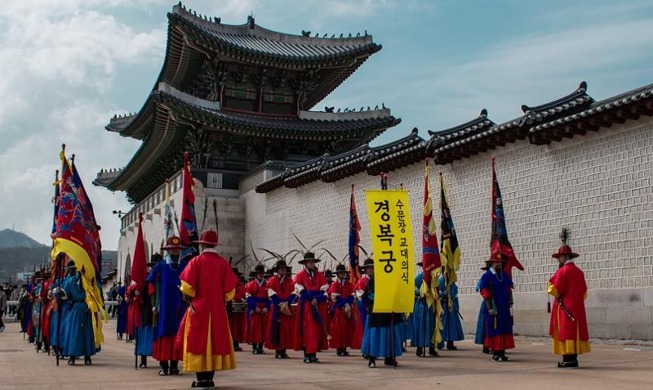-
 Korea.net's 24-hour YouTube channel
Korea.net's 24-hour YouTube channel- NEWS FOCUS
- ABOUT KOREA
- EVENTS
- RESOURCES
- GOVERNMENT
- ABOUT US
Let's imagine what we could do 40 years ago with KRW 30.
We were able to ride along the Jongno subway line that ran from Seoul Station to Cheongnyangni Station, which has now become part of metro line No. 1.
Today, four decades later, the fare has jumped 35 times to KRW 1,050. Similarly, the Seoul metropolitan subway system itself has also grown by leaps and bounds.
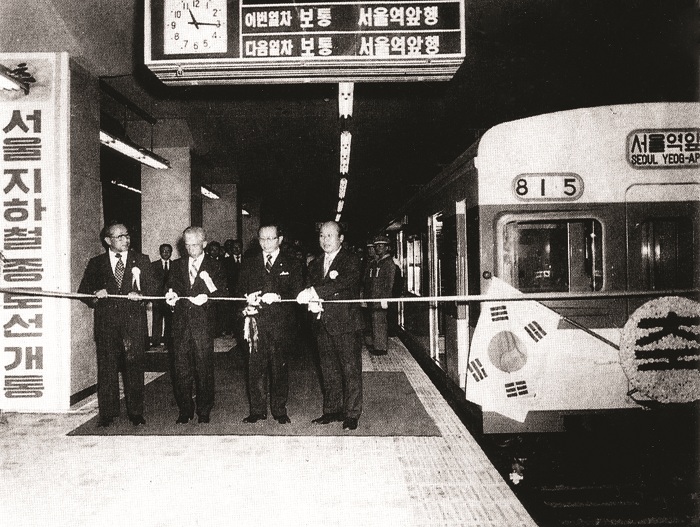
The world's first underground train was introduced in London, U.K., in 1863. It was a steam train that could only travel along 6 kilometers of tracks. After World War I, there was a worldwide boom in subway construction. The first subway train on continental Europe was constructed in Budapest, Hungary, in 1896. It was then followed by public transport systems in Vienna in 1898, Paris in 1900, the U.S. in 1901 and Berlin in 1902.
Seoul's first subway system started operations on August 15, 1974, about 110 years after the underground train's initial few European sparks. The Seoul metro system began with only one line and nine stops, travelling 7.8 kilometers from Seoul Station to Cheongnyangni Station. Today, the Seoul subway system has nine official subway lines and more than 300 stops, reaching every corner of the greater Seoul metropolitan area.
The total length of track is 327.2 kilometers, from line No. 1 to No. 9. The subway system is as long as that of New York, and, also, that of London, the birthplace of the subway. As one of Seoul's landmarks, and also as a symbol of the nation's economic development and modernization throughout the 1970s, the Seoul metropolitan has become the subject of global recognition in terms of both its size and operation capabilities.
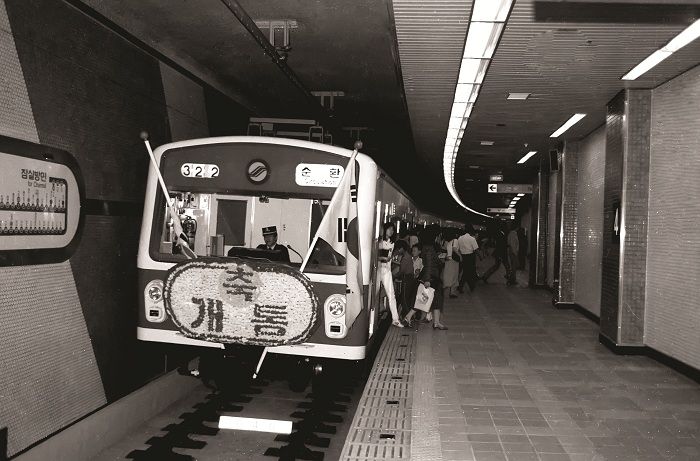
In Seoul, the beginning and end of the day has always been with the metro. As of February 26, 2014, Seoul's subway trains have carried 40 billion people over a total distance of 1.22 billion kilometers, equivalent to 25,550 trips around the Earth. Seoul's subway system is the most-used public transport systems in Korea, being used by about one third of the city's population and by an average of 7.24 million people per day.
However, the Seoul metropolitan subway offers more than just transportation. In addition to functioning as the legs of the people, it has also been providing people with some cultural offerings.
"The Seoul subway is just fantastic. Nowhere in the world can we find a subway system on which one can travel such long distances. The fare is cheap, too. You will be able to experience diverse aspects of Seoul at a reasonable price."
So said Charles Usher and Elizabeth Groeshen, a couple who authored, "Charlie and Liz's Seoul Subway Travelogue," at a press conference promoting their publication. They said they have travelled all over via the subway, making stops at more than 100 stations over the course of five years.
Stops are located as close as one minute apart and range up to as much as 15 minutes apart, depending on the destinations. Tourists in Seoul can make easy and convenient trips on the subway to visit historic sites and film shooting locations, as well as theme parks. In addition, various cultural and musical performances, as well as displays of artwork showcased in the corners of some stations, add fun to the trip.
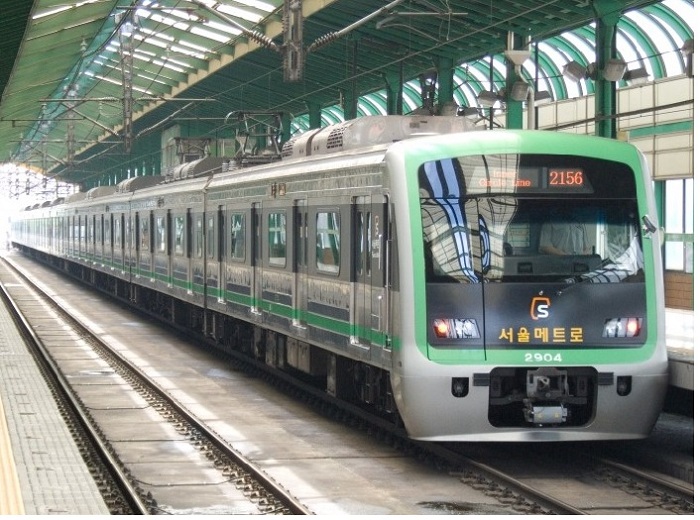
Many technological aspects of the Seoul subway system have been modeled by a number of other cities, too, including its convenient transfer system, the punctual operation of its trains and the adoption of wider turnstiles with space for baby carriages and wheelchairs. In addition to Vietnam and Indonesia, representatives from Saudi Arabia paid a visit to Korea last December to learn about its public transport systems.
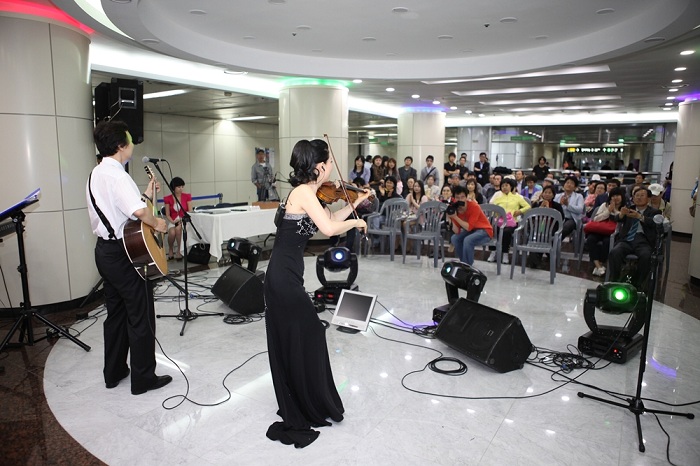
The Seoul metropolitan subway system tries to provide more convenient services to its passengers by adopting new systems that provide people with information about the arrival time of their train and which gives directions on how to transfer. The Seoul subway system also has plans to focus on the development of the city and on being more convenient for the millions of passengers it takes to and from their destinations every day.
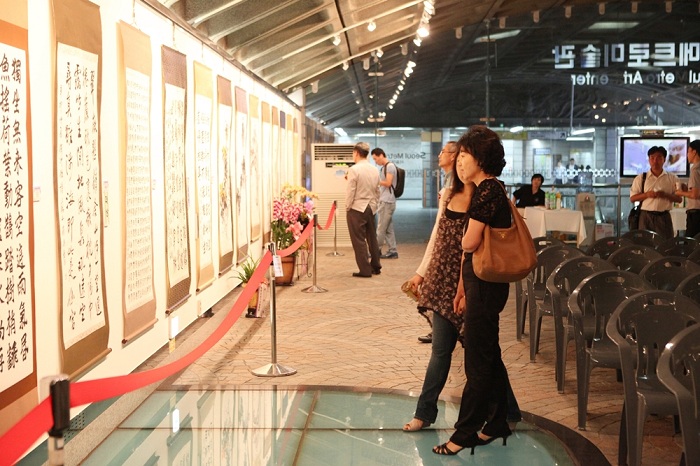
By Lee Jeong-rok, Lee Seung-ah
Korea.net Staff Writers
Jeongrok@korea.kr
We were able to ride along the Jongno subway line that ran from Seoul Station to Cheongnyangni Station, which has now become part of metro line No. 1.
Today, four decades later, the fare has jumped 35 times to KRW 1,050. Similarly, the Seoul metropolitan subway system itself has also grown by leaps and bounds.

Subway line No. 1 opened on August 15, 1974. (photo courtesy of Seoul Metro)
The world's first underground train was introduced in London, U.K., in 1863. It was a steam train that could only travel along 6 kilometers of tracks. After World War I, there was a worldwide boom in subway construction. The first subway train on continental Europe was constructed in Budapest, Hungary, in 1896. It was then followed by public transport systems in Vienna in 1898, Paris in 1900, the U.S. in 1901 and Berlin in 1902.
Seoul's first subway system started operations on August 15, 1974, about 110 years after the underground train's initial few European sparks. The Seoul metro system began with only one line and nine stops, travelling 7.8 kilometers from Seoul Station to Cheongnyangni Station. Today, the Seoul subway system has nine official subway lines and more than 300 stops, reaching every corner of the greater Seoul metropolitan area.
The total length of track is 327.2 kilometers, from line No. 1 to No. 9. The subway system is as long as that of New York, and, also, that of London, the birthplace of the subway. As one of Seoul's landmarks, and also as a symbol of the nation's economic development and modernization throughout the 1970s, the Seoul metropolitan has become the subject of global recognition in terms of both its size and operation capabilities.

Seoul's first subway train (photo courtesy of Seoul Metro)
In Seoul, the beginning and end of the day has always been with the metro. As of February 26, 2014, Seoul's subway trains have carried 40 billion people over a total distance of 1.22 billion kilometers, equivalent to 25,550 trips around the Earth. Seoul's subway system is the most-used public transport systems in Korea, being used by about one third of the city's population and by an average of 7.24 million people per day.
However, the Seoul metropolitan subway offers more than just transportation. In addition to functioning as the legs of the people, it has also been providing people with some cultural offerings.
"The Seoul subway is just fantastic. Nowhere in the world can we find a subway system on which one can travel such long distances. The fare is cheap, too. You will be able to experience diverse aspects of Seoul at a reasonable price."
So said Charles Usher and Elizabeth Groeshen, a couple who authored, "Charlie and Liz's Seoul Subway Travelogue," at a press conference promoting their publication. They said they have travelled all over via the subway, making stops at more than 100 stations over the course of five years.
Stops are located as close as one minute apart and range up to as much as 15 minutes apart, depending on the destinations. Tourists in Seoul can make easy and convenient trips on the subway to visit historic sites and film shooting locations, as well as theme parks. In addition, various cultural and musical performances, as well as displays of artwork showcased in the corners of some stations, add fun to the trip.

A Seoul Metro train in 2014 (photo courtesy of Seoul Metro)
Many technological aspects of the Seoul subway system have been modeled by a number of other cities, too, including its convenient transfer system, the punctual operation of its trains and the adoption of wider turnstiles with space for baby carriages and wheelchairs. In addition to Vietnam and Indonesia, representatives from Saudi Arabia paid a visit to Korea last December to learn about its public transport systems.

Buskers perform at Dongdaemun History & Culture Park Station. (photo courtesy of Seoul Metro)
The Seoul metropolitan subway system tries to provide more convenient services to its passengers by adopting new systems that provide people with information about the arrival time of their train and which gives directions on how to transfer. The Seoul subway system also has plans to focus on the development of the city and on being more convenient for the millions of passengers it takes to and from their destinations every day.

Gyeongbokgung Station houses an art gallery.
By Lee Jeong-rok, Lee Seung-ah
Korea.net Staff Writers
Jeongrok@korea.kr




